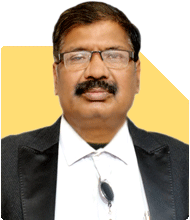Ramalingam Kalirajan |8098 Answers |Ask -Follow
Mutual Funds, Financial Planning Expert - Answered on May 21, 2024
He has an MBA in finance from the University of Madras and is a certified financial planner.
He is the director and chief financial planner at Holistic Investment, a Chennai-based firm that offers financial planning and wealth management advice.... more

Hi sir, I am going to retire at 40. I.e, this year. I will have 55 lac retirement benefits. I don't have any knowledge of mutual fund or sip. My monthly pension wud be 36000. So I planned to put 30 lac in Senior citizen savings scheme to get 20500/-. What and where should I invest rest 25 lac to get better than FD/ kvp. I don't want to take risk on lifetime achieved fund.
Retiring at 40 is a significant milestone, and it's essential to make prudent investment decisions to safeguard your retirement corpus and ensure financial stability. Let's explore tailored investment options that align with your risk tolerance and financial goals.
Maximizing Returns on Retirement Benefits
Congratulations on your retirement! With retirement benefits of 55 lakhs and a monthly pension of 36,000, you're off to a good start. Maximizing returns on your retirement benefits is crucial for long-term financial security.
Senior Citizen Savings Scheme (SCSS)
Investing 30 lakhs in the Senior Citizen Savings Scheme to earn a monthly income of 20,500 is a conservative yet effective choice. SCSS offers guaranteed returns and capital protection, making it suitable for risk-averse investors like yourself.
Exploring Investment Options for the Remaining 25 Lakhs
Now, let's focus on the remaining 25 lakhs and explore investment avenues that offer better returns than FDs or KVPs without compromising your risk tolerance.
Fixed Income Investments
Consider allocating a portion of the remaining corpus to fixed income investments such as corporate bonds, debentures, or high-quality debt mutual funds. These options provide stable returns with relatively lower risk compared to equities.
Systematic Withdrawal Plans (SWP)
Another option is to invest in mutual funds with a SWP facility. SWP allows you to systematically withdraw a predetermined amount from your investment at regular intervals. Opt for debt-oriented balanced funds or conservative hybrid funds to minimize risk while aiming for better returns.
Regular Funds Investing through a Certified Financial Planner
Investing in regular funds through a Certified Financial Planner (CFP) offers several benefits. A CFP provides personalized advice, portfolio management, and regular reviews to ensure your investments are aligned with your goals and risk tolerance. With a CFP's guidance, you can navigate market uncertainties and optimize your investment strategy for better returns.
Ensuring Financial Stability in Retirement
Retiring at a young age requires careful planning to ensure financial stability throughout your retirement years. By diversifying your investment portfolio, minimizing risk, and seeking expert guidance, you can build a robust financial foundation that supports your lifestyle and aspirations.
Conclusion
Sandeep, retiring at 40 is a remarkable achievement, and it's essential to make wise investment decisions to preserve and grow your retirement corpus. By investing in a combination of conservative options like the Senior Citizen Savings Scheme and exploring alternative avenues for the remaining corpus, you can achieve your financial goals while safeguarding your lifetime achievements.
Best Regards,
K. Ramalingam, MBA, CFP,
Chief Financial Planner,
www.holisticinvestment.in
You may like to see similar questions and answers below
Ramalingam Kalirajan |8098 Answers |Ask -Follow
Mutual Funds, Financial Planning Expert - Answered on Apr 30, 2024
Ramalingam Kalirajan |8098 Answers |Ask -Follow
Mutual Funds, Financial Planning Expert - Answered on May 08, 2024
Ramalingam Kalirajan |8098 Answers |Ask -Follow
Mutual Funds, Financial Planning Expert - Answered on May 27, 2024
Ramalingam Kalirajan |8098 Answers |Ask -Follow
Mutual Funds, Financial Planning Expert - Answered on May 20, 2024
Ramalingam Kalirajan |8098 Answers |Ask -Follow
Mutual Funds, Financial Planning Expert - Answered on Mar 13, 2025
Ramalingam Kalirajan |8098 Answers |Ask -Follow
Mutual Funds, Financial Planning Expert - Answered on Mar 13, 2025
Ramalingam Kalirajan |8098 Answers |Ask -Follow
Mutual Funds, Financial Planning Expert - Answered on Mar 13, 2025
Rajesh Kumar Singh |194 Answers |Ask -Follow
IIT-JEE, GATE Expert - Answered on Mar 13, 2025
Ramalingam Kalirajan |8098 Answers |Ask -Follow
Mutual Funds, Financial Planning Expert - Answered on Mar 13, 2025
Rajesh Kumar Singh |194 Answers |Ask -Follow
IIT-JEE, GATE Expert - Answered on Mar 13, 2025
Ramalingam Kalirajan |8098 Answers |Ask -Follow
Mutual Funds, Financial Planning Expert - Answered on Mar 13, 2025
Dr Nagarajan Jsk |277 Answers |Ask -Follow
NEET, Medical, Pharmacy Careers - Answered on Mar 13, 2025
Milind Vadjikar |1108 Answers |Ask -Follow
Insurance, Stocks, MF, PF Expert - Answered on Mar 13, 2025
T S Khurana |402 Answers |Ask -Follow
Tax Expert - Answered on Mar 13, 2025

























